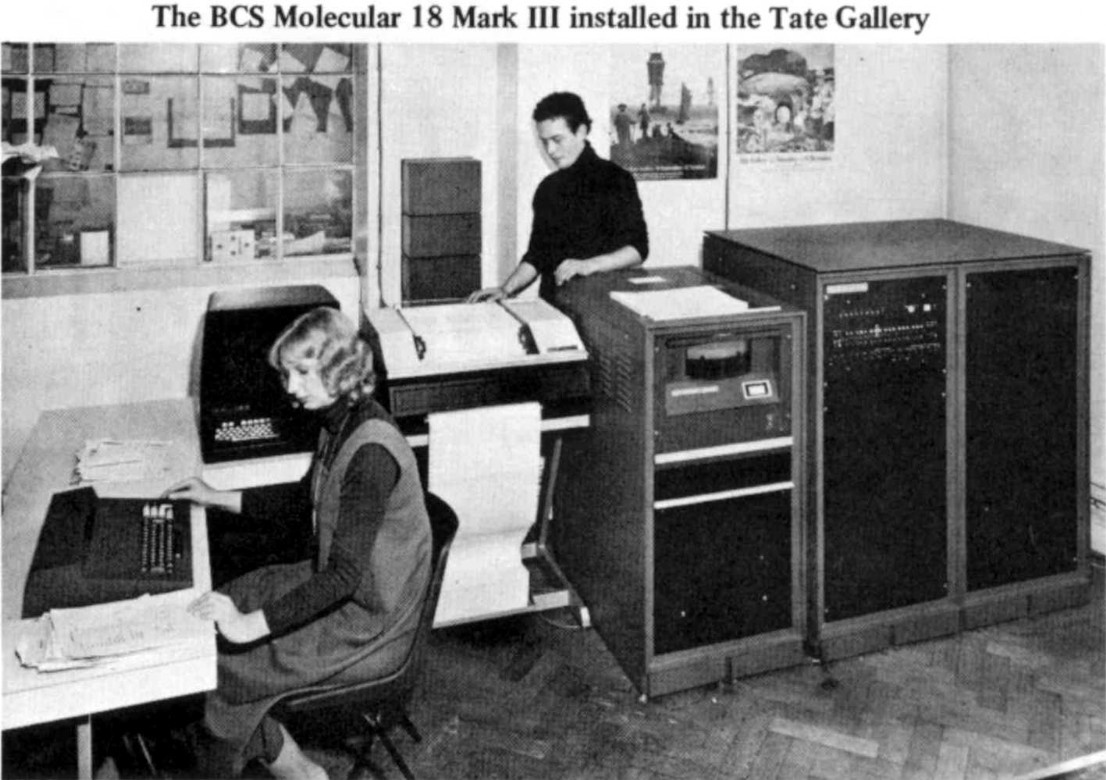
The Tate Gallery
One of the most important activities of the Tate Gallery, representing an annual turnover of half a million pounds, is its sales of reproductions of its art collection. The problems of stock control and accounting became so great that the Gallery has now installed a small business system.
A typical example of a direct entry mini computer system which provides sales accounting and stock control routines and with the facility for on-line enquiries is the BCL MOLECULAR computer in the Publications Department of the Tate Gallery.
The upsurge of public interest in art has resulted in an extensive business being built up in the sales of reproductions of the vast art collection administered by the Tate. The Publications Department generates an annual turnover of £500,000 from over 2,500 different products which are distributed throughout the UK and overseas.
To ensure effective stock control of their 2,500 different product lines and efficient sales accounting procedures they use a MOLECULAR minicomputer system supplied by Business Computers (Systems) Limited, which consists of a 12K words central processor, alpha numeric display keyboard, 200 lpm printer, visual display terminal and 5 million characters of disc storage and is basically designed to cater for a wide range of accounting functions, stock control and generation of sales and management reports.
The products marketed by the Tate fall into 12 main groups and range from framed reproductions, reference books and exhibition catalogues, to photographic slides and art post cards. More than one million of these post cards are supplied each year to the Tate’s 500 account customers, through the retail shop housed within the Gallery, and by mail order to overseas.
Supplies of stocks are held at two locations, a bulk warehouse in Cambridgeshire and in a large in-house stock room to meet day to day requirements. Customer account details, product information and stock levels, detailing separate levels for the two locations, are held on disc files.
Order data is input to the system through the keyboard or the VDU, although the latter in this instance is mainly used for customer account and stock interrogation. Under program control, the keyboard operator is guided through each step of invoicing procedure, thus reducing the possibility of errors.
Relevant customer details are entered, quantity of items required and the system completes the invoice line showing total value and VAT. Four price categories, cost, retail, trade and educational for each stock item are catered for within the system.
Stock is immediately updated on completion of each invoice line thus providing up to the minute stock accuracy to satisfy customer telephone enquiries. If, however, the invoice is cancelled for any reason, stocks are immediately returned to their correct levels. The flexibility of the system allows invoices to be printed as a simultaneous operation of keyboard input or, if the printer is being used for report production, spooled on disc for later processing. During invoice printout customer balances, master files by product group, customer sales by product group and profit by product group, are automatically updated.
On-line enquiries, such as stock levels and customer account details showing current balance and aged debt analysis over thirty, sixty and ninety days can be carried out without interrupting the progress of other work systems being processed by the installation.
Batch reports and cash posting are carried out daily. Cash posted to customer accounts is allocated to the relevant aged debt category and balances updated. A variety of reports are catered for to provide vital sales statistics.
Aged debt analysis reports for distribution to key departments are produced on a regular basis to ensure efficient cash flow.
The system which was operational within one week of installation uses standard BCL software, although modifications have been implemented in-house by Mr Mark Adams, computer controller at the Tate. These include refinements to ease the task of producing repetitive invoices which result from volume requests for catalogues during an exhibition of national appeal.
Previously a BCL Susie accounting machine was used but as work loads increased this was replaced by the Molecular system which is capable of expansion with the addition of peripherals and added processor capacity to meet future business expansion without changing hardware or software.
"We chose the system" said Mr Brian McGahan the department assistant Manager, "because of its ease of operation and capabilities for future expansion, should these be required by increased workloads. The direct entry and on-line enquiry facilities provided by the system are ideal for our operation and allow us to maintain stock at optimum levels and keep rigid control of our cash flow position which is vital in these days of high interest rates".
Published in DATA SYSTEMS (February 1977)
